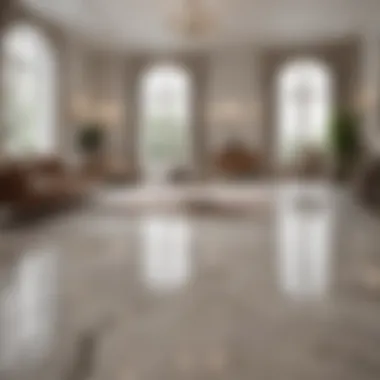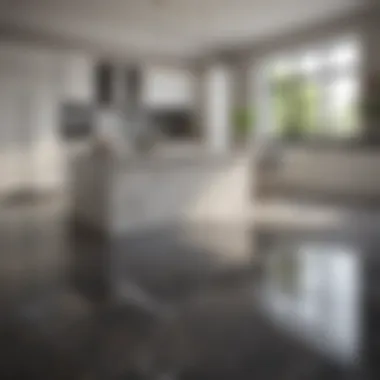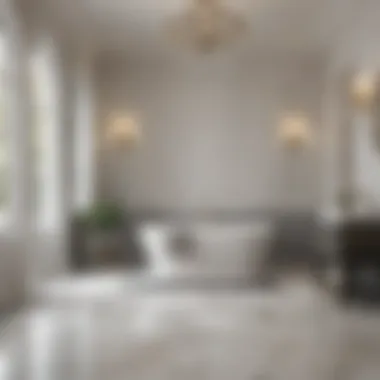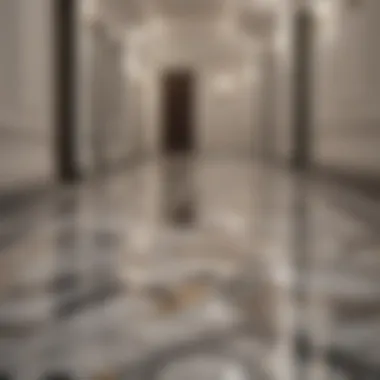Innovative Marble Floor Ideas for Modern Interiors


Intro
Marble flooring serves as an enduring symbol of luxury and sophistication in interior design. Its unique patterns and elegant finishes make it a choice that blends beautifully with both classic and contemporary styles. This article will provide a comprehensive overview of various innovative ideas for employing marble floors in modern homes. From selecting the proper styles to integrating different color palettes, each choice can influence the overall ambiance of a space. Careful consideration of maintenance and upkeep will also be discussed, ensuring that the beauty of marble is preserved over time.
By delving into the complexities of marble flooring, homeowners and design enthusiasts will gain insights that not only inspire innovative applications but also aid in functional decision-making to enhance their living environments.
Understanding Marble Flooring
Marble flooring represents a fusion of artistry and functionality, making it a central theme in modern interior design. It is essential to grasp the multifaceted characteristics of marble, as the choice of flooring can significantly influence the aesthetics and overall feel of any space. Understanding marble entails not just an appreciation of its beauty but also insight into its various types, properties, and maintenance needs. This knowledge ensures that homeowners and interior design enthusiasts can make informed decisions that align with their vision for a living environment.
Types of Marble
Carrara Marble
Carrara Marble, sourced from the Carrara region in Italy, is one of the most recognized types of marble. Its cool white to bluish-grey color, coupled with soft veining patterns, gives it a timeless appeal. This marble, favored for its classic look, fits seamlessly into both traditional and contemporary interiors. Carrara’s characteristic softness offers a luxurious finish, making it a popular choice for living areas and bathrooms. However, its propensity to stain and scratch requires vigilance in maintenance.
Calacatta Marble
Calacatta Marble is rarer than Carrara and features more dramatic veining, often in gold or grey tones. The luxurious and bold design makes Calacatta a favored option for statement pieces, such as kitchen islands or feature walls. Its striking appearance holds the power to define a room’s aesthetic, setting a sophisticated tone. While it provides a stunning visual effect, it similarly shares the susceptibility to scratches and etching, necessitating careful usage and upkeep.
Crema Marfil
Crema Marfil is another sought-after marble type noted for its warm beige tone and subtle veining. This marble is versatile and adapts well to various color schemes, enriching spaces with a soft yet warm ambiance. Its durability and ease of maintenance render it a practical option for both residential and commercial applications. The unique cream color can create an inviting atmosphere, but the softer hue may not be suitable for all modern design styles.
Properties of Marble
Durability
Marble is celebrated for its durability. While it is a natural stone, it can withstand significant wear and tear, making it suitable for high-traffic areas. Its inherent strength allows it to maintain integrity over time, ensuring it does not lose its charm or functionality. However, certain types of marble may be more prone to scratches, requiring specific care to preserve its surface.
Aesthetic Appeal
The aesthetic appeal of marble is undeniable. Its unique patterns and colors allow for diverse design possibilities. Marble introduces an element of luxury that can elevate the design of any room. Whether used as flooring, countertops, or accent walls, its visual appeal can create a stunning focal point and provide a backdrop for elegant furnishings.
Heat Resistance
Another remarkable property of marble is its heat resistance. This ability to withstand hot temperatures makes marble an ideal choice for kitchens and other areas where heat exposure is frequent. It does not conduct heat, allowing it to remain cool underfoot even in warm climates. This characteristic, combined with its beauty, makes marble a favorite among designers and homeowners for modern interiors.
Designing with Marble Floors
Designing with marble floors adds a layer of sophistication and elegance to modern interiors. The unique patterns and colors of marble can transform a space, making it a center of attention. Careful consideration is required when selecting marble for various areas of the home. The combination of aesthetics and function must be prioritized. Marble not only enhances the visual appeal but also offers practical benefits.
Combining with Other Materials
Incorporating marble floors with other materials can create a more dynamic and visually appealing space. Each material brings its own character, and their interaction can vastly enhance the overall design.
Wood Accents
Wood accents introduce warmth to marble's coolness, creating a balanced environment. The natural texture of wood contrasts beautifully with the smooth surface of marble. This combination is popular among designers due to its timeless appeal. One unique feature of wood accents is their ability to soften the starkness of marble. However, they require regular maintenance to prevent warping in humid environments.
Glass Elements
Glass elements provide a sleek look when paired with marble floors. These can include glass furniture or decorative items that reflect light and add brightness to the room. The transparency of glass contrasts nicely with the solidity of marble, offering an airy feel. It is a popular choice because it enhances the light flow. However, care must be taken with glass items as they can break easily.
Metal Fixtures
Metal fixtures infuse a modern edge into marble flooring design. Elements like metal railings, light fixtures, or even furniture can create a striking contrast. The lustrous quality of metal complements the finish of marble well. This pairing is beneficial for creating an industrial look or an upscale contemporary space. However, it is important to select metals that resist tarnishing, as they can detract from marble's natural beauty.


Color Schemes
Selecting the right color scheme is crucial for maximizing the appeal of marble floors. Different schemes can alter the perception of space and its ambiance.
Neutral Palettes
Neutral palettes offer a simple and elegant backdrop for any room. Shades of beige, gray, and white can highlight the intricate veins of marble. A key advantage of using neutral colors is their versatility; they work well with various design styles. However, they can sometimes feel bland if not paired with complementary decor.
Bold Contrasts
Bold contrasts can create dramatic visual interest. Using dark colors next to light marble can heighten the impact of the flooring. This may involve pairing rich blues or deep reds with white marble. Such a choice can assert an audacious statement in a room. However, this can also make a space feel smaller if the palette is not balanced adequately.
Monochromatic Themes
Monochromatic themes utilize variations of a single color to create cohesion in a space. Shades and tones of the same color can be soothing and visually pleasing. This approach emphasizes the unique patterns of marble without overwhelming the senses. One downside is that it might lack the vibrancy that comes with contrasting colors, potentially making the room feel less lively.
Innovative Patterns and Layouts
The use of innovative patterns and layouts in marble flooring is instrumental in defining modern interiors. Patterns add dimension and character to a space, moving beyond the conventional notion of marble as simply a luxurious material. As trends evolve, homeowners and designers seek creative options that not only satisfy aesthetic desires but also serve practical functions. Unique layouts can break monotony, guide movement through spaces, and even reflect personal style.
Herringbone Patterns
Herringbone patterns have gained popularity for their classic yet modern look. This design involves laying rectangular tiles in a zigzag formation, resulting in a dynamic visual effect. Installing herringbone marble floors requires precision but creates a striking impact. This pattern works well in various settings, from formal living rooms to contemporary kitchens. The arrangement plays with perspective, making rooms appear larger and more inviting. For those looking to incorporate herringbone patterns, it’s essential to choose colors that complement the overall color scheme of the space.
Checkerboard Designs
Checkerboard designs, while traditional, have seen a resurgence in modern interiors. The pattern typically combines two contrasting colors, creating a bold statement. This type of flooring is effective in adding balance to a room while simultaneously providing a playful touch. It is often used in bathrooms and kitchens, where the square shapes can enhance spatial flow. When selecting checkerboard marble, consider variations in finish; polished marble can reflect light, enhancing the overall brightness of the area, while honed marble offers a more muted, earthy feel.
Inlays and Borders
Inlays and borders add an element of sophistication and customization to marble flooring. By integrating different materials, such as glass or metals, these features create unique focal points. Inlays can depict intricate designs or patterns, showcasing craftsmanship and artistry. This technique is particularly effective in entryways or living areas, where the floor can serve as a work of art. Borders can also frame a room or define spaces within a larger area. Choosing inlays and borders that resonate with the room's overall design will ensure a harmonious space.
Innovative patterns in marble flooring transcend mere aesthetics; they enhance functionality and spatial dynamics.
Marble in Various Home Spaces
Marble flooring offers versatility for various home environments, making it a favored choice among homeowners and interior design enthusiasts alike. Its visual appeal and functional benefits play a significant role in enhancing both aesthetic and practical aspects of living spaces. Different areas within a home serve unique purposes and require flooring that complements their specific needs. Adopting marble flooring in these spaces is advantageous due to its durability, ease of maintenance, and classic beauty.
The considerations for integrating marble into different home spaces include factors like design coherence, functionality, and maintenance. When done thoughtfully, marble can elevate the atmosphere and enjoyment of a space where people gather, cook, relax, or enter their homes. Here are specific considerations for employing marble flooring in key areas:
Living Areas
Living areas are often the heart of a home. Marble flooring can lend an air of sophistication and elegance to this predominant space. Its inherent variations in patterns and colors create visual interest. When selecting marble for living areas, consider a finish that reduces slipperiness, as this will enhance safety without sacrificing style.
For a warmer atmosphere, pairing marble with plush rugs can balance the coolness of the stone and bring comfort. Adding accents such as wooden furniture or vibrant accessories can also help create a cozy yet elegant look.
Kitchens
In kitchens, marble flooring provides several advantages, including heat resistance and aesthetic appeal. The hard surface makes it a suitable choice for areas that face potential spills and stains. While a polished finish can enhance its beauty, a honed finish is often preferred for practical reasons, as it provides better traction when wet.
Moreover, marble can beautifully complement various cabinetry styles and countertop materials. Combining marble floors with dark wood cabinets creates a striking contrast, while light-colored marble pairs well with contemporary or minimalist designs.
Bathrooms
Bathrooms are spaces where marble truly shines. Its natural moisture resistance makes it an ideal choice for flooring, walls, and even countertops. The ability to maintain a clean, elegant look while resisting water damage is a key benefit. In this space, coolness can be a concern, especially in colder climates. Therefore, incorporating underfloor heating can provide the necessary warmth.
Designing a bathroom with marble flooring allows for creative freedom, with patterns and colors that can transform the space into a luxurious retreat. Natural stone features, integrated with modern fixtures, can create an appealing contrast that enhances the overall design.


Entryways
Entryways serve as the first impression of a home, and marble flooring can provide a dramatic entry point. It withstands heavy foot traffic and is relatively easy to clean, making it suitable for this high-traffic area. The gleam of marble can create an instant benchmark of luxury, welcoming guests with elegance.
When designing these spaces, consider using larger tiles or unique patterns to create a visually stimulating entry. Accents such as runners or mats can also provide additional protection against dirt while introducing color and texture.
Marble flooring, when applied appropriately, can harmonize with diverse styles, offering both beauty and practicality.
In summary, marble can significantly enhance different areas of a home. From living areas that need warmth and charm to kitchens that require durability, every space benefits from the inclusion of this timeless material. The careful selection and installation of marble can genuinely transform the atmosphere and ultimately, the functionality of a home.
Maintenance of Marble Floors
Proper maintenance of marble floors is vital for their longevity and aesthetic appeal. Regular upkeep not only preserves the surface appearance but also enhances the overall value of your home. Homeowners often underestimate the effort needed to maintain marble. Understanding and implementing maintenance strategies can prevent costly repairs and prolong the beauty of these elegant surfaces.
Regular Cleaning Routines
A consistent cleaning routine is essential. Dust and dirt can scratch the surface of marble, leading to dullness. Use a soft-bristled broom or a microfiber mop to remove loose particles. Avoid harsh cleaners that can etch the stone. Opt for pH-neutral solutions or specialized marble cleaners.
Tips for Regular Cleaning:
- Clean spills immediately to prevent staining.
- Use warm water for damp mopping. Avoid soaking the marble.
- A weekly routine should include sweeping or dusting followed by mopping.
Establishing a cleaning schedule tailored to the foot traffic in your space can be beneficial. High-traffic areas may need more frequent attention.
Sealing and Polishing
Sealing is a crucial step in marble maintenance. A sealant forms a protective barrier against stains and liquids. Typically, sealing should happen every six to twelve months, depending on the type of marble and the usage.
Process of Sealing:
- Start with a thorough cleaning to remove dirt.
- Apply a marble-specific sealant evenly with a soft cloth.
- Allow the sealant to absorb and dry.
Polishing adds shine and restores the marble’s luster. Professional polishing may be necessary for heavily worn surfaces. Regular at-home polishing helps maintain the surface but should be performed cautiously to avoid build-up.
Repairing Scratches and Chips
Even with the best care, scratches and chips can occur. Addressing these promptly helps avoid larger damage. For minor scratches, a marble repair kit can work wonders. These kits typically include fillers and a polishing compound.
Steps for Repairing Scratches:
- Clean the area with a damp cloth to remove any debris.
- Apply the filler according to the product instructions.
- Allow it to cure, then sand down and polish for a smooth finish.
For larger chips or cracks, consulting a professional is advisable. Trying to fix major damage can sometimes lead to further deterioration of the marble.
Proper maintenance is an investment that preserves both beauty and value of marble floors.
Budgeting for Marble Flooring
Budgeting for marble flooring is a crucial aspect of any home renovation or construction project. Understanding the financial implications of installing marble tiles can help homeowners make informed decisions and attractively enhance their living spaces. Developing a detailed budget involves assessing various cost factors, which contribute to both the short-term expenses and long-term investment value of this elegant flooring.
Cost Factors
Quality of Marble
The quality of marble is a significant factor that influences the overall cost of flooring. Higher quality marble, such as Carrara or Calacatta, offers distinctive patterns and rich color variations. This quality is not just about looks; it directly relates to durability and longevity. When considering marble, investing in high-quality stones often results in fewer issues down the line, making it a popular choice in modern interiors.
Some unique features of high-quality marble include:


- Veining Patterns: Unique and sophisticated designs that add character.
- Density and Hardness: Higher resistance to scratches and wear.
However, it's important to recognize that premium options can come at a considerably higher price point compared to lower-quality alternatives. Balancing your budget with quality choices is essential to achieve an aesthetically pleasing result with durability.
Installation Expenses
Installation expenses are another critical aspect of budgeting for marble flooring. Hiring skilled professionals for installation ensures that each tile is properly aligned and secured, which greatly influences the overall finish and longevity. This part of the budget should not be underestimated, as improper installation can lead to various issues in the future.
Some characteristics of installation expenses include:
- Labor Costs: A skilled installer may charge more, reflecting their expertise and the quality of their work.
- Preparation Work: This might involve underlayment, leveling, or addressing floor conditions before installation begins.
Choosing to go with a less experienced installer can save some costs initially, but it risks potential complications later on, leading to greater expenses for repairs.
Maintenance Costs
Maintenance costs also play a significant role in the budgeting process. Marble floors require regular care to maintain their beauty and durability. This includes periodic sealing, cleaning, and potentially addressing scratches or chips that may occur over time.
Key aspects of maintenance costs include:
- Sealing Products: Regular sealing can prevent stains and moisture damage, which is a recurring expense.
- Cleaning Supplies: Specialized cleaners might be necessary to avoid damaging the stone.
Maintaining a marble floor is an ongoing commitment, and while it may seem like an additional burden, taking proper care can extend its lifespan, ultimately making it a worthwhile investment.
Long-term Investment Value
Investing in marble flooring should be viewed through the lens of long-term value. While the initial costs may be high, quality marble flooring can elevate the overall value of a home. Many potential buyers appreciate the durability and aesthetic appeal of marble, making it an attractive feature in real estate.
Some points to consider regarding long-term value include:
- Increased Property Value: A well-maintained marble floor can be a selling point.
- Longevity and Durability: High-quality marble can last decades with appropriate care.
Considering the overall costs and potential return on investment, marble flooring can be a savvy choice for discerning homeowners.
Sustainable and Ethical Sourcing
The significance of sustainable and ethical sourcing in marble flooring cannot be overstated. As the demand for natural stone increases, so too does the need for responsible practices in extraction and production. Sustainable sourcing ensures that marble is extracted in a way that minimizes environmental impact. This includes reducing waste and energy consumption during mining processes. It also encompasses considerations regarding the preservation of natural habitats, which can be significantly impacted by large-scale quarrying.
When homeowners and designers prioritize sustainable marble, they also contribute to the support of ethical labor practices. This factor is increasingly important as the global market expands. Selecting materials from sources known for their ethical standards helps protect worker rights and ensure fair wages. Thus, investing in sustainable and ethically sourced marble offers tangible benefits not only to consumers but also to the local communities involved in quarrying.
"Sustainable marble sourcing is not just about avoiding environmental harm; it’s about creating a ripple effect that can uplift entire communities."
Additionally, opting for eco-friendly materials fosters innovation in design practices. With the push for sustainability, many designers are exploring novel ways to incorporate recycled and upcycled marble into their projects. This trend not only enhances aesthetic appeal but also positions homes as forward-thinking and environmentally conscious.
Choosing Eco-Friendly Options
Selecting eco-friendly marble options involves more than just the stone's aesthetic and quality. It requires an understanding of how the material is sourced and treated. Homeowners should seek out marble that is certified sustainable. Certifications can offer assurance that the material meets specific environmental standards.
Consider the following strategies to ensure you choose eco-friendly marble:
- Research Certifications: Look for certifications like LEED (Leadership in Energy and Environmental Design) or ISO standards that indicate environmentally responsible sourcing.
- Explore Local Suppliers: Local sourcing typically reduces transportation emissions and supports regional economies. This can lessen the carbon footprint associated with the material.
- Recycled Marble Products: Investigate vendors who offer recycled marble. This option can significantly reduce waste and is often more affordable compared to newly quarried stone.
Using these methods can lead to a more sustainable choice in marble flooring and can inspire others to follow suit, promoting a collective shift towards responsible sourcing.
Ethical Suppliers
The role of ethical suppliers in the marble industry cannot be overlooked. They play a critical part in ensuring that the marble available on the market adheres to fair labor practices and eco-friendly standards. When dealing with suppliers, transparency is crucial. Homeowners should inquire about a supplier’s sourcing practices, labor conditions, and the environmental impact of their operations.
You might consider the following points when evaluating suppliers:
- Supply Chain Transparency: Ethical suppliers should be willing to share information about their sourcing processes and the conditions under which their marble is produced.
- Worker Treatment: Look for suppliers who ensure fair wages, safe working conditions, and adherence to labor laws.
- Environmental Practices: Choose suppliers who implement eco-friendly practices, such as water recycling systems and responsible waste management.
Engaging with suppliers committed to ethical practices empowers consumers. It also encourages the marble industry to adopt more responsible methods, creating a ripple effect of positive change that extends globally.







